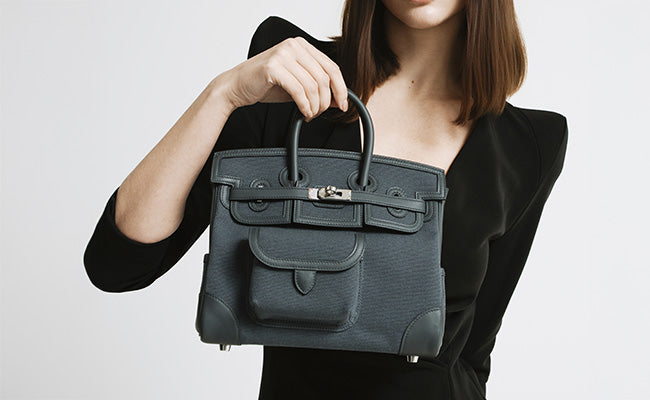
Private‑Sale Risks: Protecting Yourself from Chargeback Fraud
Check out our Hermès collection and Birkin bags!
Selling luxury items like Hermès bags privately can be incredibly rewarding, but it also opens the door to sophisticated fraudsters who see high-value transactions as prime targets.
Private sellers face unique chargeback fraud risks because they lack the robust protection systems that established retailers have, making them vulnerable to buyers who complete purchases and then falsely claim they never received items or that products weren't as described. The world of luxury resale has exploded, and unfortunately, so has the creativity of those looking to exploit it.
We've seen buyers get authentic designer pieces, enjoy them for weeks, then file chargebacks with claims ranging from non-delivery to accusations of counterfeit goods. These disputes can cost sellers not just the item's value but also processing fees and hours spent fighting off bogus claims.
Understanding how chargeback fraud works in private luxury sales isn't just smart business, it's essential if you're trading in high-end goods.
The stakes are just too high to wing it when someone's trying to walk away with your authentic Birkin bag and keep their money too.
Key Takeaways
- Private luxury sellers face higher chargeback fraud risks due to limited protection systems compared to established retailers
- Fraudsters commonly target high-value items by falsely claiming non-delivery or authenticity issues after receiving legitimate products
- Proper documentation, secure payment methods, and understanding dispute processes are essential for protecting against fraudulent chargebacks
Understanding Chargeback Fraud in Private Sales
Private sales of luxury goods like Hermès bags come with vulnerabilities when accepting credit card payments. Fraudsters take advantage of chargeback protections designed for consumers. These high-value, intimate transactions create risks that you just don’t see in traditional retail.
What Is Chargeback Fraud?
Chargeback fraud happens when a cardholder disputes a valid transaction to get a refund while keeping the item. People sometimes call this "friendly fraud," but it’s anything but friendly.
In luxury private sales, buyers often claim they never received the item or that it was "significantly not as described." Instead of working things out with the seller, they go straight to their credit card company and file a chargeback.
Common chargeback fraud tactics:
- Claiming non-delivery after getting the item
- Disputing authenticity when the product is genuine
- Pretending the transaction was unauthorized
- Complaining about minor imperfections
Fraudsters often walk away with both the item and their money back. Sellers lose the merchandise, get hit with chargeback fees (usually $15 to $100 per dispute), and waste time chasing lost funds.
How Chargebacks Work with Private Transactions
Private sellers just don’t have the same tools as big retailers. We’re missing the fraud prevention systems and paperwork that businesses rely on to win disputes.
When a buyer disputes a private sale, credit card companies launch an investigation. But private sellers usually can’t provide the detailed evidence banks want, think shipping records, customer service logs, all that jazz.
Key challenges for private sellers:
- Short dispute windows (often just 30-45 days)
- Trouble proving authenticity without original receipts
- No formal return policies or terms of service
- Sparse documentation compared to businesses
The chargeback process is built to favor consumers. Card networks want people to feel safe using credit cards, but that means individual sellers are left exposed.
Many private sellers don’t even bother contesting chargebacks because the process is messy and the odds aren’t great. Fraudsters know this and target us because we’re easier marks.
The Appeal for Luxury Buyers and Sellers
Luxury goods markets are a magnet for chargeback fraud. The high transaction values and tricky authentication make it worthwhile for scammers.
Hermès bags and other luxury items are especially vulnerable. Fraudsters claim authentic pieces are fake, knowing most sellers can’t produce airtight authentication on short notice.
Why luxury items attract fraud:
- High resale values make the scam worth it
- Authenticity disputes are tough to settle fast
- Private sellers often don’t have much documentation
- Sellers sometimes accept losses out of frustration or emotional attachment
Luxury buyers usually have higher credit limits and solid banking relationships. Their chargeback claims often look more credible to card issuers.
The prestige of luxury transactions can lull both sides into a false sense of security, making it easier for fraudsters to slip through.
Types of Chargeback Fraud You Might Encounter
Chargeback fraud isn’t one-size-fits-all. There’s friendly fraud, deliberate abuse, identity theft, and even malware-driven scams. Even seasoned luxury sellers can get blindsided.
Friendly Fraud Explained
Friendly fraud is when a buyer you’d probably trust decides to play dirty. They buy an item, receive it, and then dispute the charge, claiming it never arrived or wasn’t as described.
It’s shockingly simple. Someone buys a vintage Hermès Kelly bag, gets it in perfect shape, then tells their bank it never showed up. They keep the bag and get a refund.
Studies say 21% of consumers have lied about packages not arriving, and 22% have falsely claimed items weren’t as described. In the luxury world, that’s a huge risk.
Don’t let the term "friendly" fool you. These buyers often seem totally legit, making them tough to spot.
Common friendly fraud scenarios:
- Claiming non-delivery even with tracking proof
- Reporting pristine items as damaged
- Challenging authenticity of real pieces
- Filing disputes after changing their mind
Deliberate Chargeback Abuse
Some people make a habit of abusing chargeback protections. These aren’t one-off opportunists, they’re running a business.
Professional chargeback abusers study merchant policies, exploit timing, and use advanced tactics to boost their odds. They love private sellers who don’t have corporate-level resources.
They’ll often buy from several sellers at once, then file a bunch of disputes. The aim is to overwhelm sellers and scoop up luxury goods.
Red flags:
- Requests for odd payment methods
- Pushing for fast shipping with no tracking
- Vague, impersonal communication
- Hesitation to provide ID or verification
It’s not just the item’s value at stake. Chargeback fees (usually $15 to $100 a pop) and admin costs can push your losses well into the hundreds.
Identity Theft and Its Role
Identity theft is a nightmare because the real cardholder is also a victim. Criminals use stolen cards to buy luxury items, then the cardholder files a chargeback once they spot the fraud.
Stolen payment data comes from hacks, phishing, or card skimmers. Fraudsters go for luxury items because big-ticket purchases don’t raise as many red flags as a bunch of small ones.
The real cardholder files a legitimate chargeback, and the seller is left out in the cold, minus the item and the money.
Warning signs:
- Mismatched billing and shipping addresses
- Orders at weird hours
- First-time buyers making huge purchases
- Shipping to freight forwarders
Malware-Driven Scams
Malware is another beast. Criminals use malicious software to steal payment info or mess with transactions. Both buyers and sellers can get caught in the crossfire.
Banking trojans grab login details and card info when people log in. Crooks use this to buy luxury goods before anyone notices.
Some malware targets luxury resale sites and authentication services. These programs can swipe stored payment methods, addresses, and even authentication docs.
Mobile malware is getting sneakier. Fake luxury shopping apps or hacked versions of legit ones can steal payment info from unsuspecting users.
You’ve got to keep security software up to date, use secure payment platforms, and double-check buyer payment methods before shipping anything valuable.
Key Chargeback Risks for Luxury Private Sellers
Luxury private sellers face three main chargeback risks that can wreck your business: losing high-value items, merchant account shutdowns, and big financial penalties.
Loss of High-Value Items
When you’re selling that coveted Birkin or Kelly, losing the bag and the payment is a gut punch. Chargeback fraud is aimed at luxury goods because fraudsters know we’re talking thousands of dollars.
The Hermès resale market is a goldmine for scammers. A single dispute can cost you $15,000 or more if you lose both the bag and the funds.
Fraudsters get the goods, then claim they didn’t arrive or were fake. Since luxury items hold their value, they can flip them quickly while the dispute drags on.
Private sales are risky because we don’t have fancy fraud detection tools. Card-not-present transactions are hard to verify.
And don’t forget the chargeback fees ($20 to $100 each), plus the time and stress of fighting off bogus claims.
Merchant Account Threats
Your merchant account can become a liability if your chargeback ratio gets too high. Payment processors keep a close eye on these numbers, and luxury sellers can hit the red zone fast.
Most processors start flagging accounts if chargebacks go over 1% of transactions. With high-value sales, just a few disputes a month can get you in trouble.
If you’re flagged, expect more scrutiny, rolling reserves, or even account termination. Getting a new processor with a chargeback history? Good luck.
You might lose access to popular payment options or end up paying higher fees with high-risk processors.
Some processors put luxury sellers under the microscope from day one, just in case.
Financial Penalties and Store Credit Issues
The penalty structure for too many chargebacks piles on the pressure. Monitoring programs can charge $500 to $1,000 a month, plus per-transaction penalties.
Store credit doesn’t shield you from chargebacks. Customers can still dispute the original payment after taking credit, so you’re exposed twice.
Processors may freeze your funds, tying up cash you need for inventory. Sometimes, 10-30% of your revenue gets locked up for months.
Penalties can escalate fast in the luxury world. You might go from regular processing to heavy monitoring within weeks of a few disputes.
The paperwork alone is a headache, action plans, regular reviews, documentation, on top of running your business.
Detecting and Preventing Chargeback Fraud
Stopping chargeback fraud means using layered detection without ruining the customer experience. Modern authentication and behavioral analysis can spot suspicious patterns while keeping things smooth for genuine buyers.
Fraud Detection Methods
Digital footprint analysis is key. Check email addresses for suspicious domains or throwaway accounts.
Phone number validation can reveal a lot. Real luxury buyers usually use established carriers; scammers lean on disposable or VoIP numbers.
IP analysis can catch weird location mismatches. If someone claims to be in Toronto but always logs in from overseas, that’s a red flag.
Velocity rules watch for:
- Multiple failed payment attempts
- Address changes mid-checkout
- Sudden spikes in purchase frequency
Payment card checks add another layer. BIN checks match banks to billing addresses, and CVV/address verification blocks basic fraud.
Machine learning algorithms crunch all this data to flag risky transactions without annoying legit buyers.
Customer Experience Versus Vigilance
Finding the right balance between security and customer experience is tough. Go too hard on security and you’ll scare off real collectors.
Smart authentication works quietly in the background, analyzing data without making buyers jump through hoops.
Clear communication helps avoid unnecessary chargebacks. Detailed descriptions, authentication certificates, and easy contact options go a long way.
Ways to reduce friction:
- One-click verification for repeat buyers
- Progressive authentication that ramps up only when needed
- Transparent tracking and delivery confirmation
Fast, real-time support can stop a concern from turning into a chargeback. Quick answers to delivery or product questions can save you a lot of grief.
Trust signals, SSL certificates, verified merchant badges, help reassure buyers their transaction is safe.
Advanced Authentication Techniques
3D Secure 2.0 is the gold standard for payment authentication right now. It checks transaction history and device fingerprints to confirm legit customers without hassle.
Multi-factor authentication is a must for big-ticket sales. Biometrics or SMS codes add extra security when someone’s buying a rare Hermès piece.
Strong Customer Authentication (SCA) rules require more verification steps, something the customer knows, has, and is.
Other advanced techniques:
- Device fingerprinting for recognizing returning buyers
- Behavioral biometrics tracking typing and mouse movements
- Tokenization to replace sensitive card data
Machine learning keeps getting better at spotting fraud. These systems learn from both good and bad transactions to refine their models.
Dynamic risk scoring means security ramps up for high-value purchases but stays light for smaller ones.
How to Protect Yourself in Private-Luxury Transactions
When you’re dealing with high-value Hermès pieces and other luxury items, protecting yourself means verifying buyers, keeping detailed records, and using smart digital security. These steps can save you from the headaches of fraudulent chargebacks and identity theft.
Verifying Buyer Identity
Before taking any payment, we’ve got to know exactly who we’re dealing with. Ask for a government-issued photo ID that matches the name on the payment method.
If someone’s buying a high-ticket item like a Birkin or Kelly, don’t hesitate to request extra proof. Utility bills or bank statements dated within 30 days can confirm their address.
Red flags to watch for:
- Buyers dodging ID requests
- Names on ID and payment card don’t match
- Someone pushing you to finish the deal fast
- Requests to ship to addresses that don’t match the buyer
Video calls can help, especially for purchases over $5,000. It’s not foolproof, but it creates a record and makes impersonation a lot tougher.
Fraud detection services are worth considering. They cross-check buyer info against databases of known scammers, sometimes catching fake identities before they cause trouble.
Transaction Documentation Essentials
Every luxury deal needs a solid paper trail. Draft up detailed purchase agreements with item descriptions, serial numbers, and honest condition notes.
Snap high-res photos from every angle before shipping. Get close-ups of serial numbers, authenticity cards, and any visible wear.
Essential documentation checklist:
- Purchase agreement with verified contact info
- Authentication certificate from a recognized service
- Photos with timestamps
- Shipping records with signature confirmation
- Payment confirmation showing cardholder authorization
Keep all communication with buyers, emails, messages, whatever. That way, if someone later claims they never agreed to the deal, you’ve got the receipts.
For anything over $10,000, requiring an electronic signature on the agreement adds another layer of proof if there’s ever a chargeback dispute.
Mitigating Digital Risks
Digital security is just as important as locking up the goods. Stick to payment platforms that offer seller protection and a clear dispute process.
Skip unfamiliar payment apps or crypto for high-value sales. Use platforms that verify identities and keep transaction records.
Digital security best practices:
- Turn on two-factor authentication for every selling platform
- Don’t send sensitive financial info over email
- Stay alert for phishing, those fake buyer inquiries can get sneaky
- Install anti-malware software on your devices
Watch out for malware, too. Scammers sometimes send fake payment confirmations or shipping labels loaded with viruses.
If you get a weird payment notification, log into your account directly instead of clicking any links. This simple step blocks so many scams.
Set transaction limits with your payment processor to flag big purchases. That gives you a chance to double-check buyers before finalizing anything major.
Responding to Chargeback Claims as a Seller
When a chargeback hits, you need to move fast and have your documentation ready. Otherwise, you could lose both the money and the item.
How to File a Chargeback Response
Usually, you’ve got 30 to 45 days to respond after a chargeback notice lands in your inbox. That’s not much time, so don’t wait around.
First, check the chargeback reason code. It’ll tell you why the buyer is disputing, non-receipt, damage, unauthorized use, whatever.
Respond through your payment processor’s portal or dashboard. Most have online systems for uploading evidence and explanations.
Keep your response focused and factual. Address the specific reason code, lay out the timeline, and avoid getting emotional.
Gathering Evidence for Disputes
Solid documentation is what wins disputes. Gather everything that proves you delivered what was promised.
You’ll need:
- Shipping receipts with tracking numbers
- Delivery confirmation showing it got to the right address
- Photos of the item’s condition pre-shipping
- All buyer communication (emails, messages, call logs)
- Screenshots of the original listing with accurate descriptions
For Hermès and other luxury items, include authentication certificates, serial number photos, and receipts from authorized retailers.
Bank statements showing the payment went through can help, too. Organize your evidence in order and explain what each piece shows.
When to Involve Your Merchant Account Provider
If a dispute gets complicated or involves serious money, your merchant account provider becomes your best ally. They know the ins and outs of card network rules and can help with tricky cases.
Reach out right away if you see fraud over $500 or multiple chargebacks from the same buyer. Providers can flag patterns and sometimes give extra protection.
Some offer chargeback protection services, they’ll handle the dispute for a fee, and honestly, their win rate is often better than if you go it alone.
Loop them in if buyers threaten more chargebacks or if you suspect a larger scam targeting sellers like you.
Frequently Asked Questions
Dealing in private luxury sales means you’ve got to be on your toes, authentication, secure payments, and a rock-solid paper trail all matter. Here are some real-world questions collectors run into when hunting rare pieces outside the usual retail scene.
How can an aficionado of Hermes bags spot a red flag when buying from a private seller?
If a seller is rushing you or pushing for immediate payment, be wary. Serious Hermès collectors know these deals take time for authentication.
Sellers who won’t share detailed photos or serial numbers? That’s a no-go. Every real Hermès bag has date codes and craftsman stamps, and they should be visible.
And if the price is way below market, something’s off. Sure, private sales can be cheaper than boutiques, but a drastically underpriced Birkin usually means it’s fake.
Only accepting irreversible payments is another warning sign. Real collectors get that buyers want some protection when dropping tens of thousands.
What steps should be taken to ensure a smooth transaction when splurging on luxury items through a non-retail platform?
Always ask for lots of photos, hardware, stitching, interior stamps, the works. Use professional authentication services like Entrupy or Real Authentication if you’re at all unsure.
Meeting in person at a secure spot is ideal. Some luxury consignment shops offer safe spaces for these kinds of deals.
Set clear terms about returns and authentication windows. Get it in writing so both parties know where they stand if something goes sideways.
Check the seller’s reputation in luxury resale communities or forums. Established collectors usually have a transaction history you can verify.
Could you enlighten us on the best practices for documenting high-value transactions to prevent any post-purchase drama?
Photograph everything, item condition, serial numbers, included accessories, all of it. These pics can save you if a dispute pops up.
Write up agreements that spell out sale terms, authentication promises, and return policies. Don’t forget item descriptions, prices, and dates.
Save every message between buyer and seller. Whether it’s text, email, or platform chat, it all helps build a case if needed.
Screenshots of payment apps and bank transfer receipts are a must. Keep bank records too, just in case.
Is there a savvy way to navigate the resale market for haute couture without falling victim to a chargeback scam?
Stick with reputable consignment shops and well-known collectors. These relationships make it easier to avoid fakes and scams.
Escrow services are great for big-ticket items. The third party holds the money until you’ve confirmed the item is legit.
Start small, buy a less expensive accessory first to build trust before you go for that five-figure bag.
Join collector groups with authentication requirements. These communities share info about trustworthy sellers and scammers to avoid.
What's the real deal with payment methods for exclusive items? Which ones provide a haven from fraudsters?
Bank wire transfers work for big deals, but you’re out of luck if something goes wrong, use them only with sellers you trust.
Credit cards offer the strongest fraud protection thanks to chargebacks, but some sellers push back on the fees. Try to negotiate this up front.
Certified cheques and cashier’s cheques split the difference, there’s some security, but not as much as credit cards.
With payment apps like PayPal, always use Goods and Services for dispute protection. If a seller insists on Friends and Family, walk away. For luxury items, it’s just not worth the risk.
How do connoisseurs of the finer things keep their transactions secure while indulging in the private sale market?
We set up authentication protocols before even looking at items. Sometimes that means calling in a pro or a trusted expert who can vouch for authenticity on the spot. It’s easy to get swept up and make a hasty decision, so having someone objective helps.
Before any money changes hands, we put together a detailed condition report. Every scratch, bit of wear, or odd modification gets noted right away. That way, if there’s a disagreement later, there’s a clear record.
Insurance is another thing we have to think about with pricey items. From the moment we buy something, we make sure it’s covered, either through homeowner’s policies or a specialty collector plan. It’s not the most exciting part, but skipping it is risky.
And honestly? Building real relationships with reputable dealers and other collectors makes all the difference. Over time, those connections lead to trust, and sometimes, they’ll tip you off about a rare find before anyone else hears about it.




